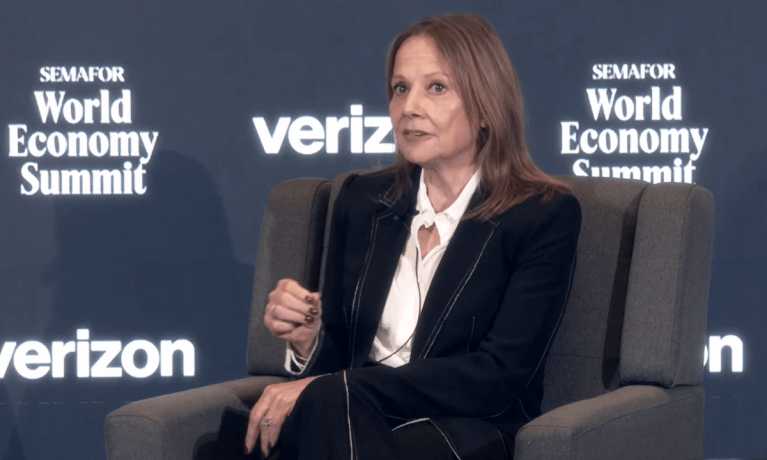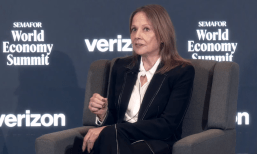GM CEO on Tariffs and GM’s EV Future

General Motors is having “very productive” conversations with the Trump administration regarding the new 25% automotive tariffs, according to CEO Mary Barra.
During a fireside chat at the Semafor World Economy Summit 2025 on Wednesday (April 23), the veteran automotive executive said that the automaker is aligned with the president on his overall goal.
“The president and the administration want to have a strong manufacturing sector in this country, and I think they very much believe they want to have a strong U.S. auto industry. So from that perspective, we’re very much aligned,” said Barra, who has led GM since 2014.
Barra said the conversations have been “constructive” as GM makes an effort to help the administration understand the capital-intensive, multiyear investment cycles of the automotive industry and its complex supply chain.
While declining to specify the potential financial impact of tariffs ahead of GM’s earnings report next week, Barra believes that harming U.S. automakers “is not the intent” of the administration’s policies.
During this period of uncertainty, she said GM is focusing on driving organizational efficiency and eliminating bureaucracy.
Barra said GM has been enhancing the resiliency of its supply chain after going through such shocks as COVID-19 and the chip shortage.
What the auto industry needs is “clarity” and “consistency,” Barra said. There is a five- to six-year development cycle for new vehicles, so predictable public policies are crucial to help GM make decisions.
When asked about competition from Chinese automakers, Barra acknowledged that their vehicles are competitive while pointing out that “the industry is subsidized by the country.”
She said GM’s vehicles “stack up quite well” component-by-component against Chinese rivdrals but emphasized the need for fair trade.
“I generally believe in free trade, but I think you have to have a level playing field,” Barra said. “I think that’s what the administration is looking to achieve.”
Read more: Report: GM Cuts 1,000 Jobs at Cruise After Ending Robotaxi Project
EV and AV Updates
On the electric vehicle (EV) front, Barra remains a believer in EVs for GM’s future and expressed confidence that consumers will eventually prefer them to gas-powered vehicles.
Last year, GM said it would delay plans for a new Buick EV as well as push back the opening of an EV truck factory, according to The Wall Street Journal. It also sold its stake in a Michigan battery plant joint venture.
Barra did acknowledge that price and the insufficient number of chargers are barriers to EV adoption. Many current EV owners still maintain a gasoline vehicle for longer trips due to “charge anxiety,” she said.
However, GM is investing in charging infrastructure, including a partnership with Pilot Flying J to build charging stations along interstate highways, and a deal with Tesla to access its Supercharger Network.
Once the infrastructure is in place, Barra said consumers will go electric. “If you’ve had an opportunity to drive an electric vehicle, never having to go to the gas station, the fact that you have instant torque, EVs … I think over time,” EVs will be the consumers’ choice.
Barra said GM has been recruiting top talent from tech companies to lead its EV transformation, including executives from Apple, Cisco and Tesla. “In our industry, that is so competitive and moving so quickly … you can’t afford to get it wrong in your first cycle,” she said.
Regarding GM’s plans for autonomous vehicles (AVs), Barra said safety remains the primary consideration. Last December, GM shut down its Cruise robotaxi business and absorbed the technology and its engineering staff. Barra said GM is now focusing on personal autonomy rather than shuttling the public in robotaxis.
Barra then cited the success of GM’s Super Cruise system — a driver assistance, but not autonomous, technology. It lets drivers take their hands off the wheel and feet off the pedals. Drivers still need to pay attention, but “you’ll arrive at your destination much more relaxed.”
She said 85% of drivers who have experienced it “would either not buy a car that didn’t have it or would strongly prefer it in their next vehicle.”
GM is working to advance Super Cruise from the current Level 2 autonomy (driver assistance) toward Level 3 and eventually Level 4, where “the vehicle is responsible and the individual is really no longer required to pay attention all the time,” Barra said.
As GM navigates these industry shifts, Barra remains focused on the company’s mission to “create a world with zero crashes, zero emissions and zero congestion,” while it is “always going to be guided by the consumer.”
Photo: GM CEO Mary Barra from livestream



